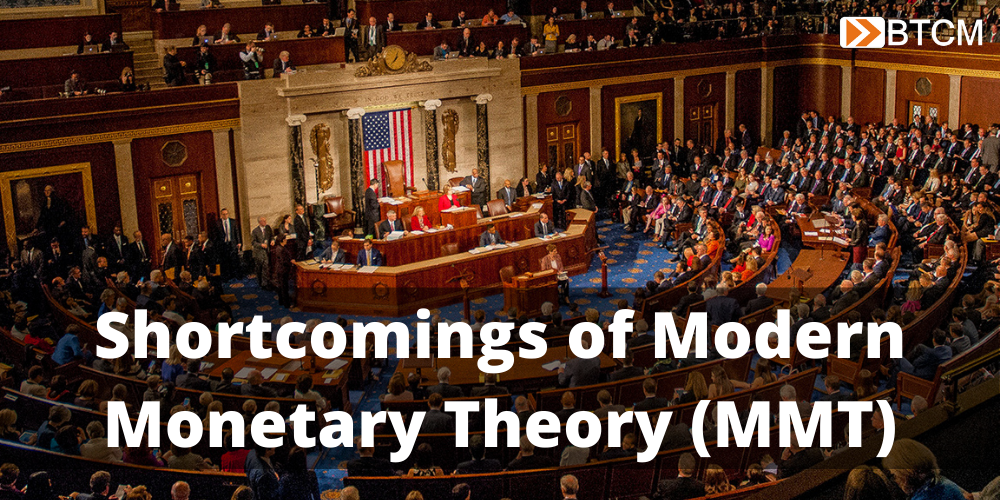Shortcomings of Modern Monetary Theory (MMT)

MMT is the new flavor-of-the-month in monetary economics. It is a big departure from both mainstream and Austrian economics, but is not new. It is a collection of several old ideas from as far back as the mid-nineteenth century, cleverly wrapped in a modern treatment. MMT's rise in popularity has coincided with the decline in effectiveness of mainstream economic policy and the subsequent rise of radical progressive socialists, as well as other central planners, who don't want to face budgetary or effectiveness constraints. This post is an ELI5 for MMT and a quick run through of its shortcomings.
Definition from the Bitcoin Dictionary:
Modern Monetary Theory - An economic theory based on the concept that a government’s monopoly on fiat money enables it to control the economy through fiscal policy alone (government spending and taxation); also known as Neo-Chartalism.
MMT Explainer
According to MMT all money comes from the State. It claims money was initially invented by governments as a way to direct economic activity. To MMTers, all money is a product of law, created by and for the State. Therefore, the government can never go bankrupt because it can print its own money. While technically true that the government can print more units of its own currency, it cannot regulate the value of that currency. This lack of a coherent value theory (why things have the value they have) pervades the entire system, as we will see below.
Typically, money is seen as the good which fulfills three functions in a society: medium of exchange, store of value, and unit of account. Goods have specific characteristics that make them perform these functions better or worse. The good with the best characteristics will become the dominant money over time or, perhaps more specifically, the global reserve currency. However, in MMT, the only function of money is funding government control of the economy (they might put it as, 'providing an economy for everyone' but that is the same thing if you believe the source of all economic activity is government). The characteristics of money, instead of scarcity, divisibility, transportability, and so forth, are morphed into properties which emerge from temporary policy decisions - e.g. government policy dictates scarcity and transportability of their money. The typical functions of money, again medium of exchange, store of value, and unit of account, are seen on par with other characteristics, as byproducts of government policy or policy aims.
In other words, if MMT were correct, the whim of a bureaucrat could wholly and instantly change the money used by society and a specific form of money would disappear with the end of whichever regime is maintaining it's legal tender status. The State could change the definition of money to be acorns and it would work the same as if it were bitcoin or gold because it is the law and the policies that matter, not any properties of the good itself. None of that is backed up by real world observations.
MMT and Taxes
MMT claims taxes create the basis for demand of the State's money. However, even MMTers realize if governments simply printed more money to pay for its spending and debts, it would quickly devalue the currency to nothing (this admits a fundamental monetarist view they deny). To stop the cycle of devaluation they turn to taxes. A minimum demand for the State's currency, they claim, is provided by the people's need for it to pay taxes.
Of course, taxes do not promote holding of the currency and, to the contrary, likely have a negative effect on demand to hold the currency. Currencies of different countries are in constant competition with each other, and even other appreciating assets. Selling a currency and repurchasing it at a lower value when needed could reduce your tax liability. Tax schemes could be designed in an attempt to thwart this activity but financial innovation could easily be designed to route around this kind of thing, with swaps for example.
MMT and fiscal policy
According to MMT, the State does not have a fiscal constraint like that found in a household budget, i.e. the need to balance income and spending, because the State can spend the money it issues. Therefore, “deficits don’t matter,” or more exactly, deficits are a policy choice. If the State can borrow in their own currency then they can simply print more to pay off any debt. MMT claims monetary policy (supply of money) and fiscal policy (taxing and spending) are two sides to the same coin. The only restraints on government spending are inflation and the availability of labor and resources in the economy.
Their rationale goes as follows. As the government spends new money it creates economic activity which leads to higher demand for labor and capital. Employment will continue to increase until a natural "full-employment" is reached, at which point any excess money printing would go directly to price increases. If spending doesn't create economic activity, but does lead to inflation, central planners can adjust taxes and spending to jump start that economic activity.
One of the huge oversights of MMT is that governments aren't the only entities that can create their own money or attempt to borrow in their own money. Any person can do this. However, it doesn't work for them because of the other side of the trade. States, as money issuers, have to be concerned with the money users acceptance. MMTers will avoid this by saying States can force acceptance, but they can't force terms of a loan. If a sovereign does not act in a trustworthy nature with their money, people will demand a very high interest rate on loans. Anyone can borrow in their own currency, it's just a question of at what interest rate. Deficits do matter, because a State must respect its debts or the market will force it to.
MMT and resource allocation
MMT makes no mention of the efficient use of labor and capital, instead focusing on top-down “full employment.” MMTers claim with proper fiscal policy the State can guarantee full employment of labor, capital, and resources. They find it impossible to explain, when using basic MMT principles, why digging holes and filling them back in is less desirable than skilled production of goods. Likely, they will say there is some measurable difference in output, but they won't be able to use a consistent standard of value to measure it.
Outcomes with equal resource inputs are considered of equal value. There is no distinction per se between the centrally directed use of resources, e.g. to manufacture tanks or bridges to nowhere, and the use of those resources elsewhere by the market. In fact, government directed spending, which is wasteful of labor or capital inputs, is seen only in context to its movement toward full employment. Once again, it is a lack of a consistent value theory that causes difficulty for MMT.
MMT theory of value
A cogent theory of value is, in our opinion, the largest problem with MMT. Instead of a subjective theory of value, where prices emerge through the preferences of individual actions - i.e. personal spending or saving decisions, MMT replaces this with a seemingly democratic or collective theory of value. It implies a populations’ collective preferences are manifest in the marginal utility of government created money. The value of printed money is inherent in the people's collective judgement of government policies, represented through the ballot box.
To unpack that a bit more, MMT argues money's value doesn't come from its utility in the functions as money but, instead, a money's utility is created by the people through their acceptance of the State, which in turn imparts value. So, first acceptance and then value, instead of a valuable thing gaining acceptance as money. The value of money is reliant on the State being the economic calculator of sorts instead of the individual. The aggregate preferences of society along with central planning expertise go into an equation and full-employment comes out the other. This is not a joke. They don't have a theory of value beyond what was just explained.
MMT on exchange rates and global markets
Also notably missing from MMT is a workable policy prescription to deal with exchange rates. The common language they use around this issue is external constraints and policy space. Interestingly, they prefer floating exchange rates because without them, MMT would have a "restricted policy space." In essence, MMTers admit the power of government policy is limited by a competitive market.
We must emphasize this point, MMT admits a fixed exchange rate leads to a situation where money and its policy characteristics are primarily limited by a market not the State. Therefore, the claim that money comes from the State is in doubt. It is the market that underpins even Chartalism. This has far reaching effects to the entire theory, similar to how the need to maintain trustworthiness in order to borrow in its own currency places the State in a subservient role, a State must also compete within an international foreign exchange market.
These shortcomings of MMT, the lack of a theory of value and the limits placed on the State through the market for debt and foreign exchange, are damning. The picture of the State spending without a care, irrespective of deficits, is a myth.




